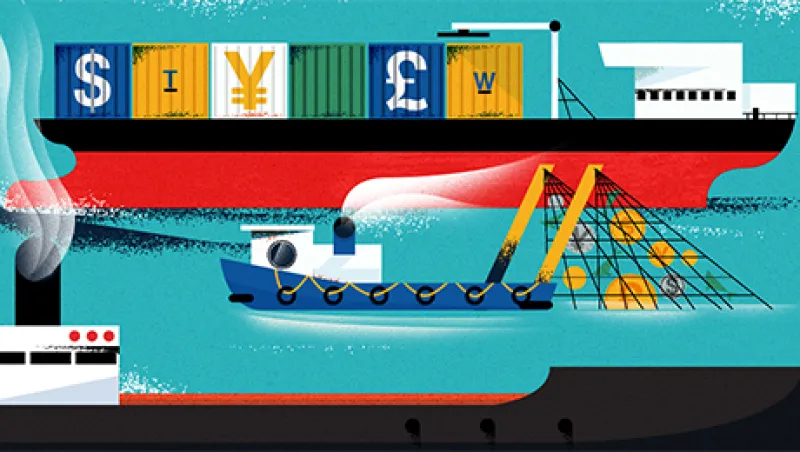It’s late on a Wednesday afternoon in early summer, and Sunil Hirani has liquidity on his mind. “We’ve been doing record volumes in the past few months,” he says of trueEX, the swap execution facility (SEF) he co-founded in 2011. “Would you like a margarita?”
There’s a party in the reception area of truEx’s headquarters in New York’s Flatiron District, and the bartender has started preparing frozen margaritas. Hirani, 48, is dressed in an electric blue suit with no tie, a look that might best be termed fintech CEO business casual. He says: “I met Jeb Bush today. He was kind of flat.” Then, without waiting for agreement, he adds, “That’s off the record!” A blur of bonhomie, jokes, self-promotion and theatrically conspiratorial, not-for-publication asides follow. Hirani is in his element. Brandishing margaritas, he bounces around dispensing refreshment to his thirsty-looking employees. Meanwhile, in smaller rooms off to the side of the party, he has, he says, “three meetings going at once.”
If Hirani, who emigrated to the U.S. from India at the age of 10 and got his start on Wall Street after completing an MBA at Northwestern University, seems adept at keeping many people happy at once, it’s because he’s constructed a career out of the act. He had already worked on the swaps-trading desks of Bankers Trust and Deutsche Bank when he founded Creditex in the late 1990s. At Creditex he built the first brokerage platform for the electronic trading of credit default swaps. At the time, the interdealer broker (IDB) world was dominated by voice trading, with dealer banks calling around to various brokerage houses in search of the best price. The IDB industry was the very definition of clubby, closed, relationship-based finance, because best execution relied on personal access to the brokers with the best prices. Executing trades electronically — on an open, transparent and potentially anonymous platform — was antithetical to the business model of the industry.
Creditex was sold to Atlanta-based Intercontinental Exchange in 2008 for $625 million. But getting Creditex off the ground was no easy task. Hirani needed the drive of an entrepreneur and the tact of a diplomat to cultivate the different sides of a complex industry and convince participants that electronic trading was the future of swaps, the derivatives used in global financial markets to hedge and manage risk. He says the experience taught him two things: “Make friends rather than enemies. Build bridges rather than burn bridges.”
At trueEX, Hirani has taken bridge building to a new level. Written off by many in the industry when SEFs — a new breed of electronic trading venue brought into being by postcrisis financial reform — began live trading 18 months ago, 45-person trueEX has succeeded in carving a niche for itself in markets dominated by much larger companies, including Bloomberg, Tradeweb Markets and legacy IDBs such as ICAP, Cie. Financière Tradition and Tullett Prebon. To succeed, Hirani has had to connect different sets of market participants — the buy side, dealer banks, clearinghouses — with disparate agendas and little appetite for change. Today, trueEX accounts for 5.7 percent of overall swaps-trading volume on SEFs; on good days it handles as much as 38 percent of trading in the market segment that links dealers directly to the buy side, according to Clarus Financial Technology, a Chicago- and London-based financial consulting firm with transaction data that is widely considered authoritative by the industry.
This is an impressive achievement: 24 companies applied to be SEFs when the U.S. Commodity Futures Trading Commission (CFTC), the agency responsible for regulating derivatives, put the final touches on new swaps-trading rules in 2013. Barely a dozen survive today, and trueEX is the only one whose sole corporate raison d’être is to be a SEF. The facilities operated by Bloomberg and Tradeweb, whose majority shareholder is Thomson Reuters, are connected to giant financial data firms, and IDB-operated SEFs are new business units within legacy brokerage houses. “It hasn’t been easy, and on-SEF trading has been much slower than many of us in the industry thought it would be,” Hirani admits. “But it’s starting to pick up.”
If part of the objective of postcrisis swaps reform was to give market participants a choice over where they executed their trades, the ability of a small, independent technology start-up such as trueEX to secure a foothold in a marketplace of Goliaths — a small success, to be sure, but a significant one — suggests those reforms may be functioning as designed. But it remains to be seen whether Hirani and trueEX can go on to help shepherd the market toward a future in which swaps trade like equities, in an open, electronic, automatic and anonymous manner.
Swaps reform was a signature project of the Dodd-Frank Wall Street Reform and Consumer Protection Act, which President Barack Obama signed into law five years ago today. The opacity and complex lines of collateral and counterparty risk associated with the over-the-counter swaps market were widely seen by lawmakers as a chief culprit in the meltdown of American International Group amid the global financial crisis of 2008–’09. In passing Dodd-Frank, Congress aimed to bring accountability and transparency to the derivatives market by shifting swaps from the old bilateral, voice-driven OTC trading model to new open, electronic trading venues: SEFs.
This was a mammoth undertaking. The global OTC swaps market had a notional value of $630 trillion at the end of 2014; in previous years the market was even bigger. Reforming swaps was about more than just SEFs. Dodd-Frank also said swaps transactions would need to be processed through central clearinghouses and reported to swaps data repositories. In effect, the statute gave birth to three new primary institutions to manage the risk associated with swaps dealing: SEFs, swaps clearinghouses and swaps data repositories.
In the lawmakers’ ideal, 2010-era vision, cleared swaps (some would be allowed to remain uncleared) would eventually migrate to an execution model that looked a lot like the equity market. The dominant trading protocol — the mechanism to match buyers and sellers — would resemble the real-time, transparent order book in use throughout the world’s major equity exchanges, with bids and offers ranked by competitiveness and displayed anonymously to give participants visibility into the best market around every security available for trade. Though opacity once ruled, now all swaps participants would see the same prices and be able to trade with one another free of intermediation and interference. In derivatives circles this trading nirvana soon had a name: all-to-all.
In practice, all-to-all was always going to be a tough sell. Both Bloomberg and Tradeweb have operated electronic platforms for swaps trading since the mid-2000s. Until Dodd-Frank, volumes on these platforms were flat to nonexistent. Absent a regulatory shock, the derivatives industry had no appetite for electronic swaps execution. Swaps traders were accustomed to a world in which different participants patrolled circumscribed domains of expertise and influence. The buy side contacted dealers with order requests; dealers would figure out a market among themselves, leaning on IDBs for assistance, before quoting a price back. Voice was the dominant means of communication, and personal relationships were essential to finding the best price. Dealers liked that world because it allowed them to feather a fee into the spread between the price they settled among themselves and what they quoted to the buy side. The IDBs survived on execution commissions. The big buy-side firms could shop among dealers for the best terms, confident that a larger trading book was a pathway to more-exclusive dealer access and better pricing. Everyone had a stake in the old system; forcing swaps to trade electronically on anonymous order books would kill the edge most participants in the market enjoyed.
From 2011, when the CFTC began the difficult task of translating Dodd-Frank’s occasionally inscrutable precepts into binding rules, resistance from the swaps industry was predictably intense. At different times over the past five years, market participants have contended that swaps reform would inhibit financial innovation, freeze liquidity, drive derivatives trading offshore, kill corporations’ ability to hedge risk and destroy the swap as we know it. To date, there has been no flood to vindicate these antediluvian predictions of woe. Despite fierce initial resistance, most incumbents have embraced, however reluctantly, the need for reform. Mandatory exchange trading of swaps began in early 2014. SEF volumes are now dominated by ICAP, Tradition, Bloomberg and Tradeweb, according to Clarus Financial Technology. All these players entered the SEF era with existing client bases and established strengths. Only trueEX had to build its house from scratch.
“At the beginning we had no customers,” says Hirani. “We had nothing. It takes money and time to connect to SEFs. Most people wanted to wait and see how the arms race would evolve.” Initially, dealers were reluctant to do business with an untested execution venue because they had no idea which of the original 24 SEFs would be most successful in attracting liquidity. The buy side hesitated to send business trueEX’s way because the company had no dealers. SEFs needed to plug into clearinghouses that warehouse the risk and hold collateral. TrueEx had many ducks to line up.
But Hirani saw an opening. As 2013 began, an arcane debate emerged over whether institutions with a declared intention to operate SEFs should apply to be designated contract markets (or DCMs, the legal term for an exchange) or wait to register as SEFs once the CFTC finalized rules. TrueEX decided to register as both, changing its name from trueSEF in the process. Because the rules around DCMs were already in place, trueEX could begin live trading and testing before SEF registration and the official timeline for mandatory electronic execution of swaps kicked in. Other would-be SEFs hesitated as they waited for the rules to be finalized — and suffered as a result.
“That was a huge foot in the door for us,” says Christina Landry, who joined trueEX in late 2011 as one of its first employees and is now head of product development. “We got in before the rest of the competition, especially the other smaller players.” Early DCM registration also gave trueEX connectivity to major clearinghouses, particularly Chicago-based CME Group and London’s LCH.Clearnet Group. “That allowed us to do a whole host of things,” says Lauren McFall, trueEX’s chief marketing officer and another of Hirani’s earliest hires. “It made us part of the market structure.”
Swaps, which at their heart involve the exchange of cash flows based around movements in an underlying asset, are very complex instruments. Many variables, including tenor, currency, start and payment dates, and day count convention determine the precise economic relationship between counterparties to a swap. Hirani knew legacy players — the IDBs, Bloomberg and Tradeweb — would dominate trading in the most-liquid swaps. To get its foothold, trueEX adopted a “flanking strategy,” he says. “Everyone else was focused on the standard five-year U.S. dollar interest rate swap. We went to the buy side and asked them what they needed that they weren’t getting from anyone else.” TrueEX became a specialist at executing nonstandard, especially non-U.S. dollar, swaps with unusual dates and coupons. “The world is episodic,” Hirani says. “The world is custom. Let people do what they want to do.”
Whereas most other SEFs have a closed-box approach to technology integration, trueEX built an open application programming interface (API) — essentially, a software plug-in — that allows buy-side firms to link their own order and execution management systems directly to the SEF, a major boon in a trading universe where straight-through processing and the reduction of human “touches” are keys to efficiency. “The incumbents do not do that,” says the head of rates trading at a leading asset management firm. “We have to build to them; they do not build to us. TrueEX has made everything fully customizable.”
Above all, by listening to the needs of the buy side, trueEX has, against the odds, carved out its niche. Overall the buy side has fewer resources than the sell side; balance sheets and technology capabilities are smaller. The open API was a major step toward winning the loyalties of money managers, but other innovations in packaging and pricing have been equally important. TrueEX is the only platform that offers two-way trading, in which buy-side users request a price from dealers without indicating whether they intend to buy or sell. The platform’s portfolio compression tool, which allows users to price multiple trades as one package, has also proved a hit.
“Before trueEX, the workflow was mainly through email, chat and spreadsheets,” says Hicham Hajhamou, head of fixed-income trading at AQR Capital Management. “They took a very old way of executing and brought it into the 21st century. You can now execute a portfolio of swaps electronically in a very efficient manner.” He adds that the trueEX interface also wins points for aesthetics: “Cosmetics and a user friendly platform are still important.” Today, from a base of zero in mid-2013, trueEX counts 17 dealers, 67 buy-side firms and 12 clearinghouses among its customers. Hirani has his audience — by all accounts a captive one. And he has very clear targets for where he would like to get to: some 25 dealers, 500 buy-side firms and 13 clearinghouses.
The CEO’s broader ambition may prove difficult to fulfill, however. Eventually, he says, trueEX will try to do more trading in standard swaps. “We’re going to expand out to include things like Treasuries, then bring it back to the order book. Because that is the future.” But the order book, quite plainly, is not the present.
Trading on SEFs today is still far from the seamless, real-time, anonymous, all-to-all process Dodd-Frank’s framers had in mind. The dominant protocol is “request for quote” — essentially, an electronic form of the voice-based price discovery method used in the pre-SEF era. For now users are more comfortable with this, notably because it locks in economics favorable to incumbents. To date, volumes on the few order-book platforms built by SEFs have been underwhelming to the point of invisibility.
But Hirani is confident that as swaps users get more comfortable with electronic trading, a more wholehearted embrace of the order-book model — which by cutting out rent seeking and fee taking by intermediaries should reduce bid-ask spreads and make trading much cheaper — will naturally follow. And he’s already developing tools to cater to needs the buy side will have once that still-remote world materializes: trueEX already allows users to allocate an average price to all accounts across a portfolio of trades, avoiding the headache of having to price each account individually. “When order books get liquid, this will be very helpful,” says AQR’s Hajhamou.
Hirani acknowledges that for now “we’re not fighting that fight that hard because we need to get in the door first.” Order-book trading, he predicts, “will take years. But the market will get there.” Characteristically, he is optimistic that trueEX will be there when it does. The danger with every small tech start-up is that its innovations will be copied by larger incumbents. The sheer cost and hassle associated with connecting to SEFs ensures there’s some stickiness to trueEX’s user base, but Hirani is conscious of the need to continue the fight to maintain and grow market share. The key, he says, is to “keep innovating and never stop moving.”
His confidence is understandable. The road to postcrisis swaps reform is paved with small SEFs that didn’t quite make it. TrueEX has succeeded, at least for now. In the five years since Dodd-Frank passed, critics from within Wall Street have often cast financial reform as an internecine struggle between regulation and innovation — the dead hand of government versus the light touch of enterprise, power bringing down progress. The unlikely rise of trueEX, a creature born equally of regulation and innovation, suggests this mortal enmity has perhaps been overblown.
Get more on trading and technology and regulation.
Visit Aaron Timms’s blog and follow him on Twitter at @aarontimms.







